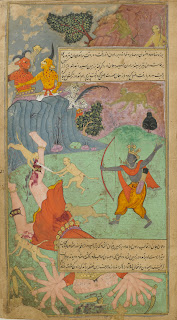Dear reader,
In an earlier post I had documented the existence of Razmnama, a Persian translation of the Mahabharata that was undertaken under Akbar's regime. This post is about 'Freer Ramayana' which, from what I have been able to gather, is an illustrated manuscript of the Indian epic Ramayana which was painted for a Moghul nobleman. There is no accurate information on who this nobleman was but the style of artwork it uses is quite similar to the ones found in Akbar's aforementioned work. So it could be that Akbar was the Moghul who had sanctioned this project too. Any further information on this would of course be appreciated.
Given below are some of the pages I could gather. What is curious about it is the consistent usage of horns (as seen in depictions of Satan/Shaitaan) to depict evil characters in them while the Kings have the symbol headdress commonly seen in Islamic and Christian art. What is also interesting is the use of predominantly red and black to depict the evil characters in the epic while the heroes are shaded in human form.
In an earlier post I had documented the existence of Razmnama, a Persian translation of the Mahabharata that was undertaken under Akbar's regime. This post is about 'Freer Ramayana' which, from what I have been able to gather, is an illustrated manuscript of the Indian epic Ramayana which was painted for a Moghul nobleman. There is no accurate information on who this nobleman was but the style of artwork it uses is quite similar to the ones found in Akbar's aforementioned work. So it could be that Akbar was the Moghul who had sanctioned this project too. Any further information on this would of course be appreciated.
Given below are some of the pages I could gather. What is curious about it is the consistent usage of horns (as seen in depictions of Satan/Shaitaan) to depict evil characters in them while the Kings have the symbol headdress commonly seen in Islamic and Christian art. What is also interesting is the use of predominantly red and black to depict the evil characters in the epic while the heroes are shaded in human form.
 |
| Angada kills Devantaka |
 |
| Angada kills Narantaka |
 |
| Bharata sets out to find Rama |
 |
| Dasharatha in Ayodhya |
 |
| Dasharatha and sons return to Ayodhya |
 |
| Hanuman and Ravana |
 |
| Hanuman beheads Trisiras |
 |
| Hanuman looking for Sanjeevani herb |
 |
| Indra prevents Trishanku from entering heaven |
 |
| Kumbhakarna getting up |
 |
| Kumbhakarna in battle |
 |
| Hanuman carries a mountain back |
 |
| Rama kills Maharaksha |
 |
| Rama kills Viradha |
 |
| Rama Lakshama Sita Hanuman |
 |
| Rama leaves for heavens |
 |
| Rama slays Shambuka |
 |
| Rama slays Ravana |
 |
| Rama with the Vanaras |
 |
| Ravana abducts Sita |
 |
| Ravana loots Kuvera |
 |
| Rysasrunga travels to Ayodhya |
 |
| Sugreeva in battle |
 |
| Sugreeva attacks Kumbhakarna |
 |
| Valmiki getting the tone of Ramayana from a dying bird |
 |
| Garuda and Vsnu |
 |
| Dasharatha being cremated |
 |
| Shatrughna killing Lavanasura and conquering Mathura |






3 reflections:
Good post, SK. It is very nice to see that our epics are translated into other languages. I thoroughly enjoyed viewing all the paintings. Thanks for collecting the info and sharing it with us.
@Sandhya: Yes. It is quite interesting that the Moghuls went to this extent to document the epics of the lands they had conquered. Them being huge patrons of art and culture rings true.
I recently visited a light show in Delhi where the narrator explained about translations during the Moughal time specially during Akbars dynasty.
Post a Comment